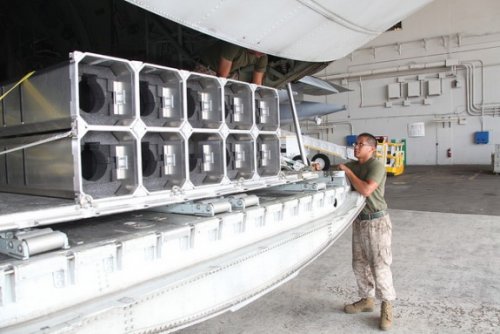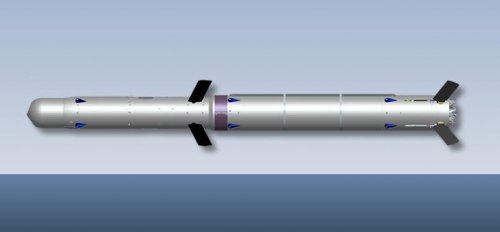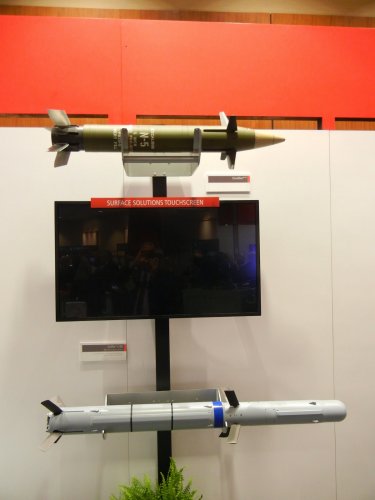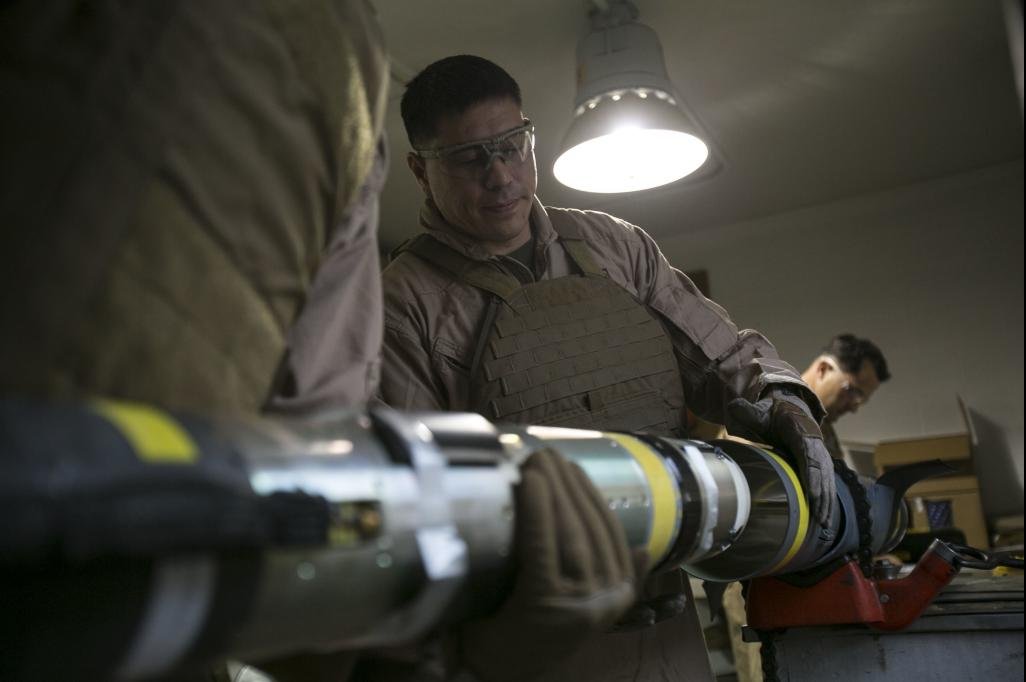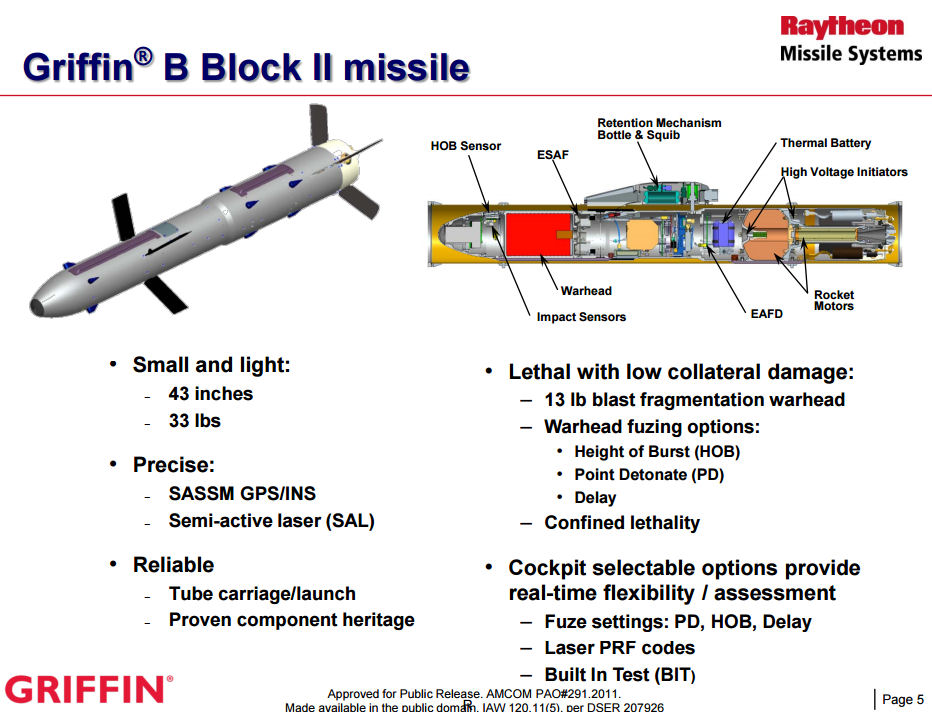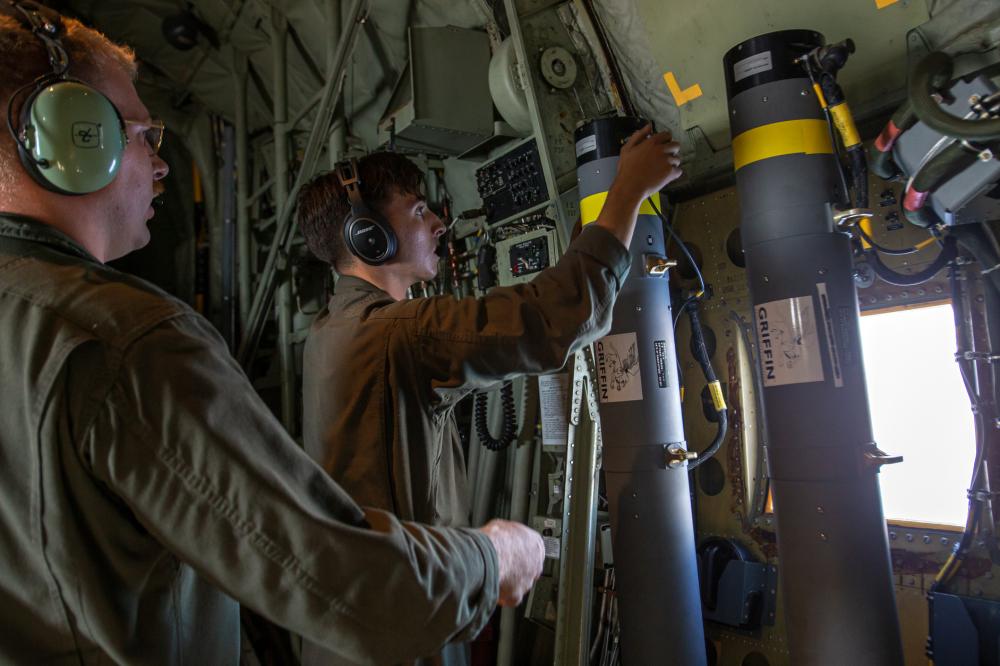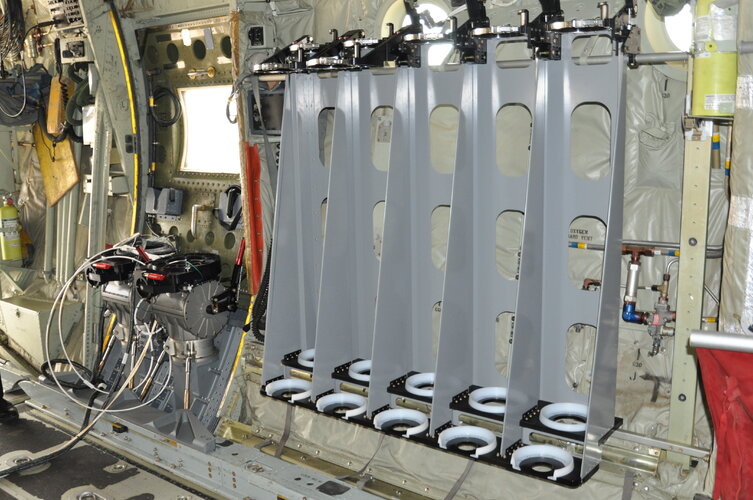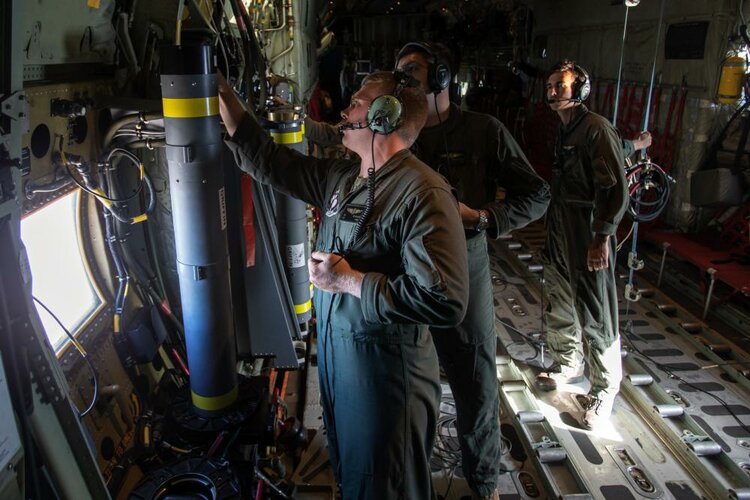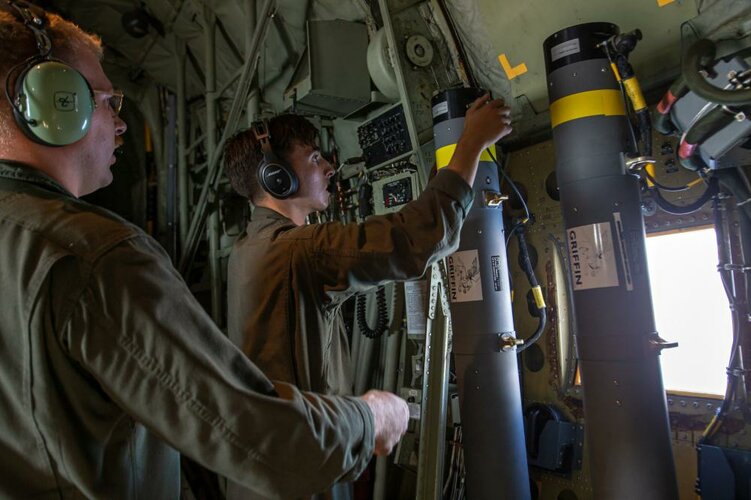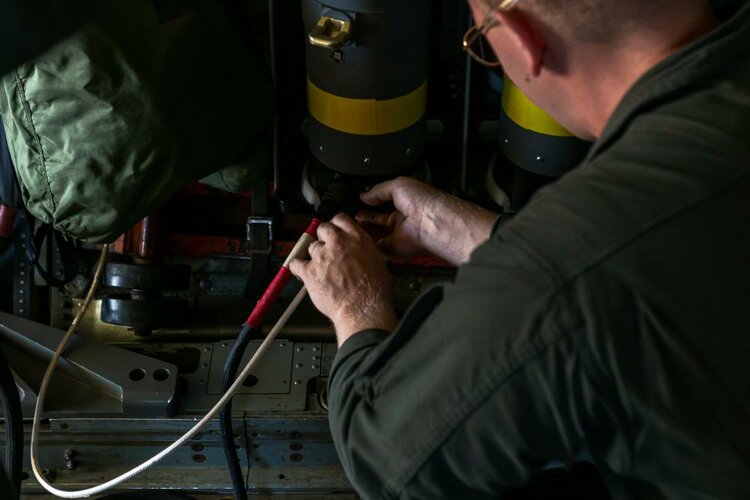Initialization Mode
- takes 20-45 seconds and transfers primary mission data to missile
- Coordinate updates only done once in Live mode
- Nav convergence done within 90 seconds
- GPS IMU alignment and target data sent to missile
- reports ready to BMS after this is all done
Missile Ready Mode
- Once good navigational/ GPS data received
- MEWS and Block 3 have last pulse logic algorithm
Fire Mode
- takes 4-8 seconds
- Consent and Armed switches must be activated. All consents on before armed switches
- Arms CLT not weapon
- Takes 5-7 (max 9) to fire weapon
- Pulls solenoid pin for up to 9 seconds
Safe Separation Mode
- ejection of weapon from CLT occurs
- fins come out after 500 ms
- missile rolls to put GPS on top of missile
- missile wont climb until below 1000ft below launch altitude
Capture Mode
- takes 3 to 5 seconds
- fin movement to stabilize movement
GPS Terminal Mode
- takes 3 to 5 seconds
- takes most direct path to GPS/IMU data coords
- Rocket fire after 5 seconds (EAFD timer expired)
- SAL seeker activates 6 seconds after munition ejected
- If no laser info weapon goes to GPS targets
SAL Terminal mode
- Takes approx 6 seconds
- If sees correct laser code will go to it
- normally 10-20 seconds after eject
- TSE updates flight path whole way through
https://quizlet.com/118856028/firing...s-flash-cards/
SAL
- semi active laser
- provides terminal guidance (last 10 seconds of flight)
- loss of laser energy will result in missile impacting last predicted intercept point
- Laser code must match what is in system and missile
TSE
- Target state estimator
- measures azimuth and elevation from the SAL to determine final target location in three dimensions
MEWS
- 3.2 lbs of explosive
- 9400+ pieces of fragmentation
- area lethality of 25 ft
GPS antenna/receiver
- Used for precise hits
IMU
- provides and angular and velocity information
- 3 gyroscopes and 3 accelerometers
Fins
- Launched .5 seconds after launch
Guidances logic prevents....
- missile climb until below 1000ft below aircraft launch altitude
Rocket motor ignition...
- about 5 seconds after launch
- 180 lbs of thrust over 4.5 seconds
EAFD
- electronic arm fire device which fires rocket motor and arms warhead
Battery
- 28 V DC battery sustaining 2 min TOF
- Do not attempt to handle for 45 min after a suspected launch
CAS
- control actuation system
- 4 fins and thrust vector control vanes
- fin is 4.6 inches
https://quizlet.com/118853106/major-...m-flash-cards/
SCM
- stack control module
- 2 stack control modules that provide command and control signals for up to 10 munitions
- controls the initialization of the corresponding stack of 5 PGMS
LPCM
- Logic and Power control module
- Conditions and distributes power to the BMS
- Located above launch portals
- BMS safety switches and WOW/ramp interlock voltage route into LPCM
SIU
- switch interface unit
- reads statuses of hardware safety switches
PGW ATACNAV
- provides data required for munition initialization which includes GPS/INS position data and 1 pulse per second signal
- Sends GPS time mark, position data to ACE server
GPS antenna
- provides GPS signal and data to Griffons and both ATACNAVS
PDU
- power distribution unit
- provides power for circuit breakers for LPCM, WOW override switch, key-loading terminals and two Mission Interference Units
- located between CLT portals
- 28V DC battery
- Separate PDU for GBUs to give power to BRU's
CLT
- common launch tube
- holds Griffons
- Safety solenoid pin to keep munition in tube
- 1-1 and 2-1 can be fired in pressurized conditions
- can ripple 3 griffons across stack
C-Migits
- ccode miniature integrated GPS/INS tactical system
- provides attitude and navigation data to BMS-2 and each ATACNAV
- 3D position, velocity, time, heading, angular rate and acceleration
- references DTED information
- Must put in proper INS TH to properly align aircraft
- Takes 2 minutes to align
Describe griffin engagement management system.
BMS. Based on target to griffin assignment. Up to 3 targets assigned 1 per griffin. Must meet specific conditions before firing, contact or airburst settings. PRF must match the same one designating.
How many pre-formed fragments does the MEWS (Multi-Effects Warhead System) warhead produce?
9400
-HIA >65 SAL seeker terminal Guidance within 6500' and 6 consecutive target reports within LFOV
True
The proximity fuze begins transmitting a Continuous Wave FM signal at __ sec prior to projected impact
10
This parameter only affects the size of the Circular Error Probability (CEP)-50 and CEP-90 bounds of the Griffin moving target footprint that is generated via the Griffin's DLL (see Section 15.3.3). Static footprints are unaffected. This setting only provides further release guidance and has no effect on the actual munition.
Reflectivity
Once transition is made to SAL Mode, guidance will not transition back to GPS target location - Starts calculating target location using Target State Estimator (TSE) • Guidance Kalman Filter used to estimate location (x,y,z) and velocity (vx,vy,vz) of target position • If the target is not moving, velocity terms will approach 0 • If SAL data is lost, will guide to last calculated TSE location
True
Describe the safe separation for the AGM-176 and GBU-39
GBU-39/B will be released from the wing in the following order: outer aft, outer forward, inner aft, inner forward. The weapon will fall 2,000ft flip over. If rippled will establish safe separation from other weapons via 60' spacing and 100' from the aircraft. Once the weapon acquires GPS the weapon is considered ready for high order detonation.
AGM-176 is ejected backwards from the aircraft sensing a 5g ejection force. The weapon will fall 1,000ft and deploy its fins to aim roughly towards the target. It will begin to acquire GPS and fire the rocket motor. After the rocket motor finishes its boost the ESAF is armed and the weapon will go high order.
What is the difference between HIA and LIA for the AGM-176?
LIA: is the default condidtion for the AGM-176. It computes the most direct path to the target. It increases maneuverability and decreases the CEP of the weapon because the seeker head opens immediately after the rocket motor fires.
HIA: maintains a flat, high flight path to the target coordinates provided at launch. It guarantees a 65deg impact angle at the target. The CEP of the weapon decreases because the seeker head does not provide guidance until the last 6000'
What are the field of view (FoV) and field of regard (FoR) for the AGM-176? What is the difference between the two?
FoV +/- 15deg and FoR +/- 30deg. FoR is the maximum viewing angle for the SAL. At this range it can determine that laser energy is coming in from this direction .It cannot, however, do anything other than turn the missile towards that energy return. The TSE cannot engage or provide flight guidance when the reflected energy is in the FoR region. The FoV is the heart of the SAL. Here the SAL is fully functional and the TSE will engage for additional flight guidance. The SAL will also take over primary guidance from GPS.
What are the run down times for the batteries in a Griffin or SDB?
The SDB has a run down time of 3 hours and the Griffin has a run down time of 45 minutes. During this time weapons? cannot manipulate the weapon because it is considered to be a live weapon with valid coordinates. This time limit is based on the time it takes the chemical reaction to stop producing enough thermal heat to power the weapon.
Describe warnings, cautions, and notes associated with the AGM-176.
Warnings
-Do not attempt to handle the missile (AUR) for at least 45mins if the battery has or is suspected to have fired.
-Employment without SAASM keys will likely result in the missile missing the intended target if using a GPS/INS terminal guidance attack. Employment using the SAL for terminal guidance, without SAASM keys, is acceptable but not recommended.
-The Griffin A-1/A-2 SAL does not contain a pulse logic algorithm. It is possible for the missile to track a ground based laser designator. Use of a ground-based laser designator should be carefully planned and coordinated.
Notes
-Both the BLACK update key (103040) and BLACK monthly key (101040) should be loaded each time the missile is keyed. The update key is required to decrypt the monthly key and must be loaded first.
-The missile must have a PRF laser code for launch and the SAL seeker is active during flight even if the operator intends the missile to be GPS/INS terminal guidance. Therefore the missile does not have a true GPS/INS only guidance mode, and the missile will guide to a laser spot with a valid PRF laser code even if not intended by the aircrew
-If key loading is attempted more than three times using a non-compatible data protocol the GPS will protect itself from suspected tampering and zeroize. The missile is unusable for employment and must be sent back to depot.
-If the BIT failure happens on the IMU, it is recommended to attempt up to five power cycles to see if the BIT will clear. Early Block (AGM-176A) missile showed an intermittent IMU power up issue which can be cleared by a cycling power.
Describe PGM safety features.
AGM-176
-Griffin guidance logic prevents any steering input that would require the missile to climb until the missile is 1000ft below aircraft launch altitude.
-Electronic Safe Arm Fire (ESAF) decides whether or not to arm the warhead. ESAF must sense ejection from the launch tube, umbilical disconnect, fins to an extended and locked position, and rocket motor acceleration
-Rocket motor ignition occurs approximately 5 secs after ejection.

